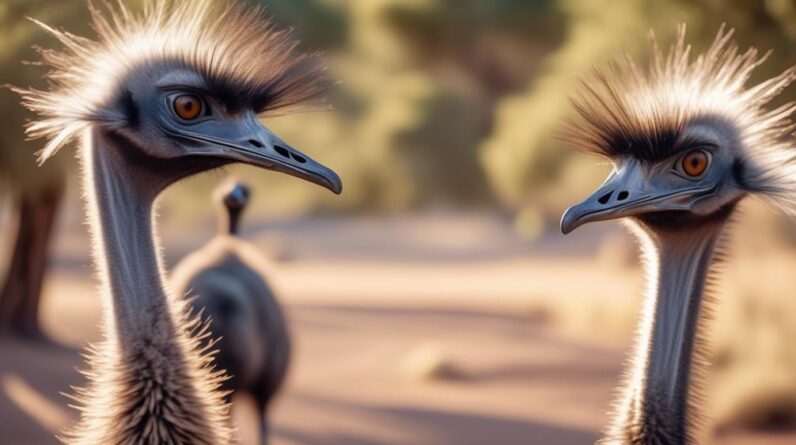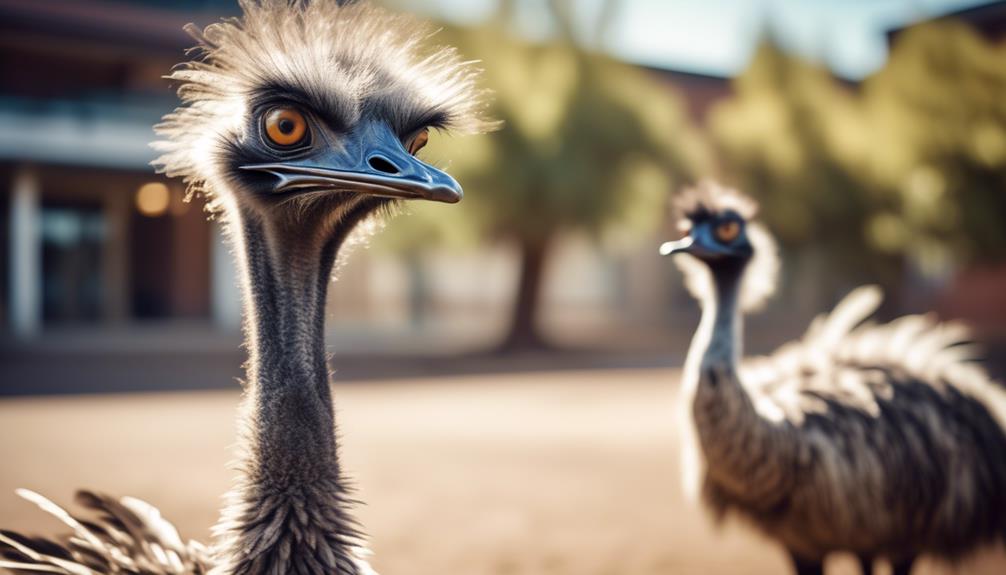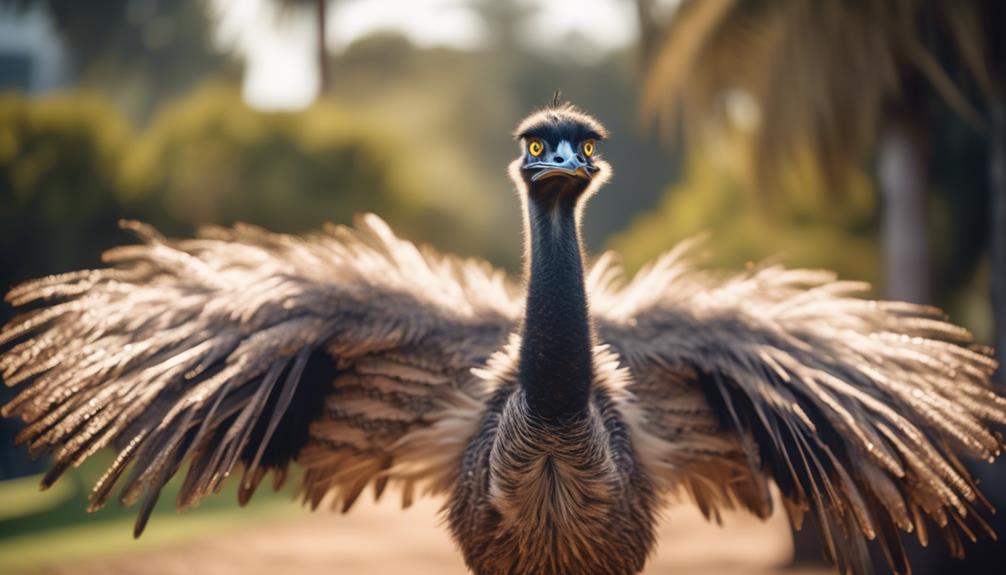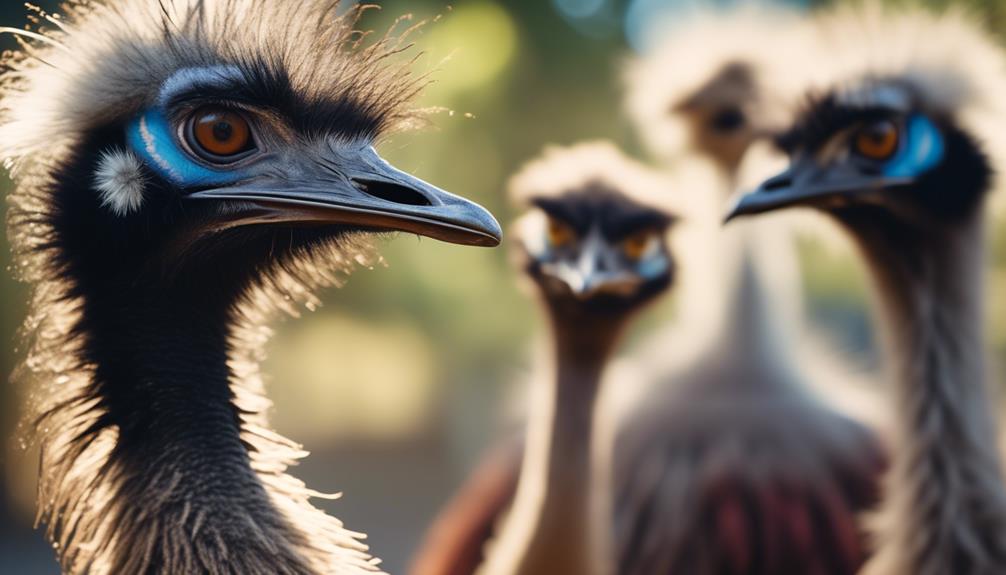
Imagine stepping into the captivating world of emus, where their language is a symphony of sounds and their movements are a dance of communication. As you observe these magnificent creatures, you begin to realize that there is much more to their interactions than meets the eye.
You find yourself curious about the meaning behind their unique vocalizations, the significance of their head movements, and the secrets hidden within their feathered displays. How do emus convey their intentions and emotions? What intricate messages lie within their mesmerizing dance moves?
In this exploration, we will unravel the fascinating ways in which emus communicate, delving into the depths of their sounds and movements, and gaining a deeper understanding of their intricate social dynamics.
The Sounds Emus Make

Emus communicate through a variety of vocalizations, which play a crucial role in expressing their emotions and establishing social connections within their group. These large flightless birds have an extensive vocal repertoire that consists of various calls and sounds.
One of the most common vocalizations is a booming sound, which is produced by males during the breeding season. This deep, resonating call can be heard from a great distance and serves as a means of attracting females and asserting dominance over other males.
Emus also use different calls to communicate with their offspring. When a mother emu wants to gather her chicks or warn them of potential danger, she emits a soft, low-pitched sound. This call helps the chicks to identify their mother and stay close to her for safety. Additionally, emus can make high-pitched hissing sounds when they feel threatened or agitated. This non-verbal communication method serves as a warning to potential predators or intruders.
In addition to vocalizations, emus also rely on non-verbal communication methods to convey their intentions and emotions. They make use of body language, such as raising their feathers, puffing up their chests, or stomping their feet, to express dominance or aggression. These physical displays are essential in establishing social hierarchies and maintaining order within the group.
Vocalizations and Their Meanings
Vocalizations play a crucial role in emu communication, allowing them to express their emotions and convey meaningful messages to other members of their group. Emus use a combination of vocal and nonverbal cues to communicate with each other effectively. By understanding the different sounds and movements, researchers have been able to decipher their meanings and gain insights into emu behavior.
One important aspect of emu vocalizations is pitch. Emus have a wide range of vocalizations that vary in pitch, from low rumbling sounds to high-pitched calls. The pitch of their calls can indicate different emotions or intentions. For example, a high-pitched call may indicate excitement or aggression, while a low rumble may indicate a more relaxed or content state.
To better understand emu vocalizations and their meanings, here is a table summarizing some common vocalizations and their possible interpretations:
| Vocalization | Meaning |
|---|---|
| Low rumble | Contentment or relaxation |
| High-pitched call | Excitement or aggression |
| Grunt | Warning or alarm |
| Drumming | Courtship display |
| Hiss | Threat or warning |
Body Language and Gestures

Body language and gestures play a crucial role in emu communication, providing additional cues and context to their vocalizations. Emus, as social animals, utilize various physical signals to convey messages to each other. These social signals can be observed in their daily interactions and are essential for maintaining social cohesion within emu groups.
One common form of emu body language is the territorial display. When an emu wants to establish its dominance or defend its territory, it raises its neck and feathers, making itself appear larger and more intimidating. This display is often accompanied by a deep booming sound produced by the emu's inflatable neck sac, which further reinforces its territorial claim.
Another important gesture in emu communication is the head shake. When an emu shakes its head from side to side, it's a clear signal of aggression or warning. This movement, coupled with a sharp hissing sound, serves as a deterrent to potential threats and helps maintain the emu's personal space.
Additionally, emus use body movements such as head bobbing and wing flapping to express excitement, submission, or courtship. These gestures are often accompanied by vocalizations that further enhance the message being conveyed.
Head Movements and Their Significance
Head movements play a significant role in the communication repertoire of emus, conveying important messages and facilitating social interactions.
One key head movement commonly observed in emus is head bobbing. This movement consists of a rhythmic up and down motion of the head, which can be seen during various behavioral contexts. Head bobbing is often associated with courtship displays, where the male emu will bob his head up and down to attract the female's attention. This movement serves as a visual signal of the male's readiness to mate and can be accompanied by vocalizations.
Additionally, head movements are essential for establishing and maintaining eye contact, a crucial aspect of emu communication. Eye contact allows emus to establish a connection and convey intention. When two emus make eye contact, it can signify a range of behaviors, including dominance or submission. For example, a dominant emu may maintain strong eye contact while approaching a subordinate individual to assert its dominance. On the other hand, a submissive emu may avoid direct eye contact as a sign of deference.
Wing Displays: What Do They Mean?

Wing displays in emus serve as visual signals, conveying important information about their social status and intentions. These displays are particularly evident during breeding behavior and territorial disputes. Understanding the meaning behind these wing displays can provide valuable insights into emu communication.
- Wing Flapping: When an emu flaps its wings rapidly, it's a display of dominance. This behavior is often seen during territorial disputes, where the emu is asserting its dominance and establishing its territory.
- Wing Drooping: On the other hand, if an emu keeps its wings drooped and close to its body, it signifies submission. This display is often observed when a subordinate emu is acknowledging the dominance of another individual.
- Wing Drumming: Emus also have a unique behavior called wing drumming. This involves the emu rapidly beating its wings against its body, creating a drumming sound. Wing drumming is believed to serve as a courtship display, signaling readiness for breeding.
- Wing Stretching: When an emu stretches its wings wide, it's often a display of threat or aggression. This behavior is typically seen during territorial disputes, where emus use their expanded wingspan to intimidate rivals.
Understanding Tail Movements
To better understand emu communication, it's important to study their tail movements, as they play a significant role in conveying important messages.
Emus use their tails to communicate a variety of emotions and intentions. One common tail movement is tail wagging, which is seen when emus are excited or agitated. This movement involves the tail rapidly swaying from side to side, creating a rhythmic motion. It's often accompanied by vocalizations such as low booming sounds or hisses.
On the other hand, tail fluffing is a behavior observed when emus are feeling threatened or defensive. During this display, the emu raises its tail feathers, making them appear larger and more prominent. This serves as a warning to potential predators or intruders, indicating that the emu is ready to defend itself if necessary.
The Role of Feathers in Communication

Feathers in emus play a crucial role in their communication system, conveying important messages through various visual displays. These feather displays, also known as plumage communication, allow emus to communicate their intentions, emotions, and social status to other members of their species.
Here are four ways in which emus use their feathers to convey messages:
- Upright feathers: When an emu stands with its feathers erect, it indicates that it's alert and ready for action. This display is often seen when emus perceive a potential threat or when they're asserting dominance.
- Fluffed feathers: Emus fluff their feathers when they want to appear larger and more intimidating. This display is commonly used during confrontations or territorial disputes.
- Feather shaking: By rapidly shaking their feathers, emus create a visual ripple effect that catches the attention of others. This display is often used to communicate excitement or to signal the start of a group activity, such as mating or foraging.
- Feather ruffling: When emus ruffle their feathers, it signifies relaxation and contentment. This display is commonly observed when emus are in a calm and peaceful state.
Through these feather displays, emus are able to convey a wide range of messages to each other, facilitating communication within their social groups. The intricate language of feathers allows emus to establish hierarchies, express emotions, and maintain social cohesion.
Emus' Unique Dance Moves
Emus' unique dance moves serve as another fascinating aspect of their communication repertoire, demonstrating their ability to convey messages through rhythmic and coordinated movements. These dance moves play a crucial role in emus' mating rituals, where males showcase their vitality and attract females.
One significant dance move performed by emus is foot stomping. When a male emu spots a potential mate, he starts by lifting one foot off the ground and then forcefully bringing it down, creating a distinctive thumping sound. This foot stomping behavior serves multiple purposes. Firstly, it helps to draw the attention of nearby females, as the vibrations produced by the stomping can be felt through the ground. Additionally, the sound and visual display of foot stomping demonstrate the male's strength and dominance, indicating his suitability as a potential partner.
Emus' unique dance moves also involve the coordination of their entire body. During the courtship display, males stretch their necks upwards, raise their wings, and sway their bodies from side to side. This synchronized movement showcases their physical fitness and agility, which are desirable traits in a mate.
Social Interactions and Hierarchy
Social interactions and hierarchy among emus are complex and play a crucial role in their overall behavior and survival. These interactions are governed by a dominance hierarchy, where individuals establish their rank within the group.
Here are four key aspects of emus' social interactions and hierarchy:
- Dominance hierarchy: Emus establish a pecking order within their social groups, with dominant individuals having higher status and privileges. This hierarchy helps to minimize conflict and maintain social order.
- Ritualized displays: Emus use various visual displays and postures to assert dominance or submission. These displays include puffing up their feathers, erecting their necks, and holding their bodies upright. By using these displays, emus communicate their social status and intentions to others.
- Vocalizations: Emus also use vocalizations to establish dominance and maintain social bonds. The dominant individuals often produce deep booming sounds, while subordinates emit softer calls. These vocalizations help emus communicate their rank and maintain social cohesion.
- Social bonds: Emus form strong social bonds within their groups. They engage in grooming behaviors, such as preening each other's feathers, which helps to strengthen social relationships and promote group cohesion. These bonds are essential for cooperation, protection, and overall group success.
Understanding emus' social interactions and hierarchy provides valuable insights into their behavior and survival strategies. By studying these complex dynamics, researchers can gain a deeper understanding of these fascinating creatures and their intricate social lives.
Communication Between Emu Pairs and Groups
Establishing dominance and maintaining social order is just the beginning – emus' communication extends beyond their hierarchical interactions. Emus utilize a variety of communication signals to convey information between pairs and groups, playing a crucial role in their courtship behavior and overall social dynamics.
When it comes to courtship, emus engage in a mesmerizing display of communication. The male initiates courtship by making soft drumming sounds, which can be heard up to two kilometers away. This drumming is accompanied by a series of low-frequency grunts and booming calls, creating a unique auditory experience. These vocalizations serve as an invitation for the female to approach and participate in a synchronized dance. The male raises his neck and tail feathers, while the female responds by mirroring his movements. This intricate dance of synchronized movements and vocalizations allows the pair to establish a bond and strengthen their connection.
In group settings, emus rely on visual signals to communicate with one another. They use a combination of body postures, feather ruffling, and head movements to convey their intentions and maintain social cohesion. For example, when an individual feels threatened, it may puff up its feathers, stand tall, and make quick, jerky head movements to signal aggression or dominance. Conversely, a relaxed emu will have its feathers sleeked down and display more fluid head movements.
Frequently Asked Questions
Are Emus Able to Communicate With Other Bird Species?
Emus communicate with other bird species through a combination of vocalizations and body language. Their unique calls and movements allow them to convey messages and establish social bonds, enhancing their ability to interact and cooperate with different avian counterparts.
What Is the Purpose of Emus' Unique Dance Moves?
Emus' unique dance moves serve a crucial purpose in their mating rituals. These elaborate movements, including head-bobbing and wing-fluttering, are a form of courtship display. They signal strength, coordination, and reproductive fitness, attracting potential mates.
Do Emus Use Their Feathers to Communicate With Each Other?
Emus use their feathers as visual signals to communicate with each other. Through nonverbal communication, they convey important messages such as dominance, courtship, and territorial boundaries. Their feathers serve as a captivating display, enhancing their intimate interactions.
How Do Emus Establish Their Social Hierarchy Within a Group?
Emus establish their social hierarchy within a group through dominance displays, vocalizations, and body language. They use these methods to assert their rank and establish order among themselves.
Is There a Difference in Communication Between Emu Pairs and Larger Groups?
In larger groups, emus communicate through complex vocalizations and movements. However, when pairs of emus bond, their communication becomes more intimate and focused. This difference in communication allows for stronger social bonds and coordination within the pair.
Conclusion
You might think that emus are just big birds that make funny noises, but their communication methods are far from simple.
From their vocalizations and body language to their unique dance moves, emus have a complex system of communication that rivals any scientific study.
So next time you see an emu, take a moment to appreciate the intricacy of their communication. It's a fascinating world of sounds, movements, and gestures that will leave you in awe of these remarkable creatures.





